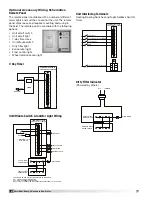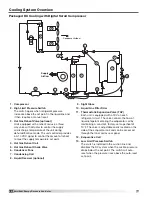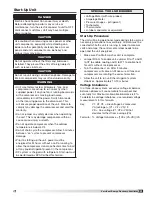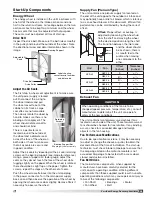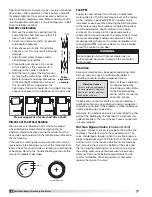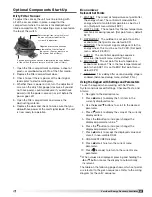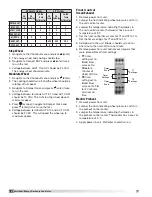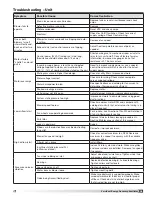
25
VersiVent Energy Recovery Ventilator
Supply Fan (Plenum Type)
The unit contains one plenum supply fan located on
the end of the unit opposite the outdoor air intake and
may optionally have a relief air blower which is referred
to as an exhaust blower in this document. Efficient fan
performance can be maintained by having the correct
offset.
Start-Up Components
Energy Wheel
The energy wheel is installed in the unit’s airstream with
one half of the wheel in the intake airstream and one
half in the return airstream. Air leakage between the two
airstreams has to be kept to a minimum and the wheel
has air seals that must be adjusted for that purpose.
The seals must be adjusted at time of start-up.
Drive Belt
Inspect the drive belt. Make sure the belt rides smoothly
in the pulley and around the outside of the wheel. Note
the directional arrow and data information shown in the
image.
Adjust the Air Seals
The first step in wheel seal adjustment is to make sure
the unit power supply is locked
out. Disconnect the wiring to
the wheel module and pull
the wheel cassette out of the
cabinet on its tracks. Large
cassettes are not removable.
Then slowly rotate the wheel by
hand to make sure there is no
binding or misalignment. The
wheel should rotate smoothly
and should not bind.
There is a perimeter seal
located around the outside of
the wheel and a diameter seal
across the face of the wheel on
both sides. Check to make sure
that all air seals are secure and
in good condition.
Adjust the air seals by loosening all the air seal retaining
screws on the bearing support (see image for reference).
Using a piece of paper as a feeler gauge, adjust the
seals so they almost touch the face of the wheel while
tugging slightly on the paper. When the wheel is rotated,
there should be a slight tug on the paper. Tighten the
screws, repeat the steps on the other set of seals.
Push the wheel cassette back into the unit and plug
in the power connector. Turn the main power supply
back on and then observe the operation of the wheel by
opening the wheel access door slightly. Remove filters if
necessary to observe the wheel.
Label showing
cassette serial number
and date code
Bearing Support
Drive Pulley
Adjustable Air
Seals
Drive Belt
Bearing Support Bar
Showing air seal assembly
Retaining
Screws
CAUTION
When operating conditions of the fan are to be
changed (speed, pressure, temperature, etc.), consult
manufacturer to determine if the unit can operate
safely at the new conditions.
Inlet
Cone
Offset
Wheel
Unit
Fan
Offset
(inches)
Tolerance
(inches)
VER-45
QEP-15
5
±
1
⁄
8
QEP-18
6
3
⁄
8
±
1
⁄
8
VER-65
QEP-18
6
3
⁄
8
±
1
⁄
8
QEP-20
7
±
3
⁄
16
VER-90
QEP-20
7
±
3
⁄
16
QEP-24
8
5
⁄
8
±
1
⁄
4
Offset:
Proper offset, or overlap, is
adjusted by loosening the wheel hub
from the shaft and moving the wheel
to the desired position along the shaft.
The transition between the inlet cone
and the wheel should
be as shown; there is
a smooth feel to the
profile when moving
one component to the
other.
The unit contains two forward-curved exhaust fans
located on each side of the unit. These forward-curved
fans should be checked for free rotation. If any binding
occurs, check for concealed damage and foreign
objects in the fan housing.
Fan Performance Modifications
Due to job specification revisions, it may be necessary
to adjust or change the sheave or pulley to obtain the
desired airflow at the time of installation. The start-up
technician must check blower amperage to ensure that
the amperage listed on the motor nameplate is not
exceeded. Amperage to be tested with access doors
closed and ductwork installed.
Fan Belt Drives
The fan belt drive components, when supplied by
manufacturer, have been carefully selected for the
unit’s specific operating condition. Utilizing different
components than those supplied could result in unsafe
operating conditions which may cause personal injury or
failure of the following components:
• Fan Shaft
• Bearings
• Motor
• Fan Wheel
• Belt
Exhaust Fan




